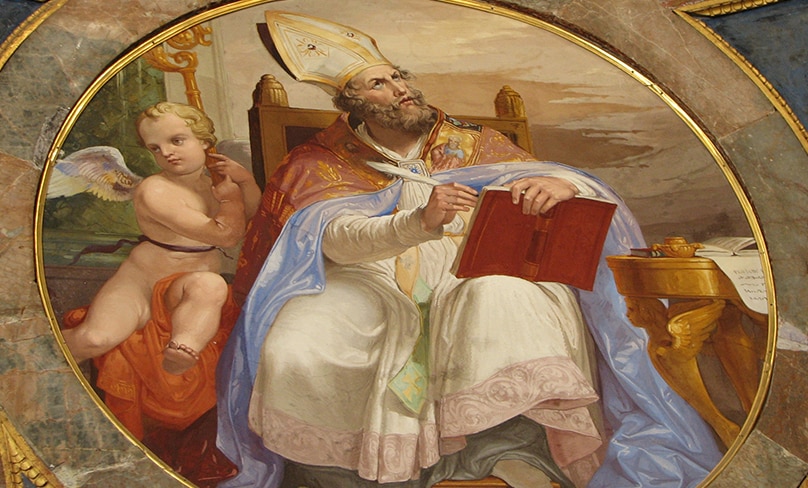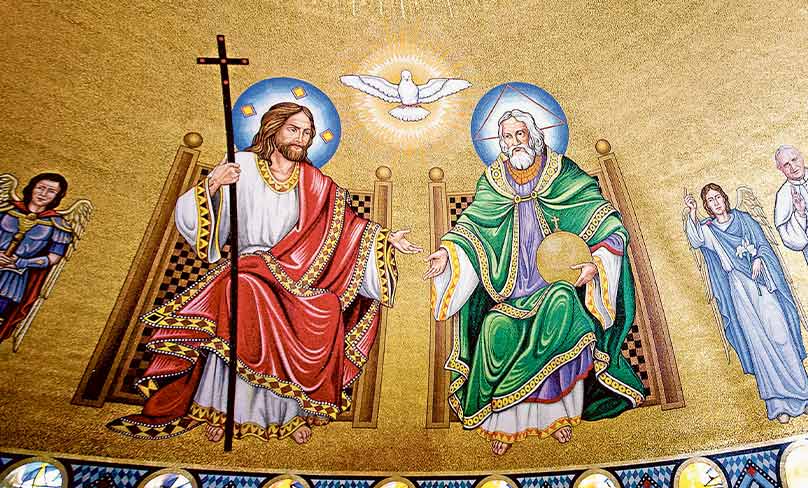
The Mass for the Most Holy Trinity,
St Mary’s Cathedral, Sydney, 4 June 2023.
It’s a scene you could picture on the beach of Bondi or Manly on a summer’s day. A boy is digging a hole in the sand, frantically running backwards and forwards to the water’s edge to fill his little well with a seashell-full of seawater at a time.
But strangely, instead of a lifesaver or bikini girl coming up to him, a bishop in full liturgical vestments happens upon the scene.
He’s obviously the absent-minded professor type, inappropriately dressed for the beach and mumbling something about “The one in three and three in one.”
The wandering ecclesiastic watched the boy for a while and finally asked him what he was doing. “Can’t you see?” the boy answered, “I’m moving the sea from over there to here.”
“That’s impossible,” replied the churchman, “the sea is too large and your well is too small.”
The boy stopped what he was doing and looked up at the great doctor and said: “Indeed it is, but it would be easier to empty the whole sea into my little well than to get the great mystery of the Holy Trinity into your small head.”
The boy then vanished, leaving the man alone with his bruised ego and no closer to solving the mystery.
The man was St Augustine of Hippo, the boy either an angel or the Christ child himself appearing.
Many consider Augustine the greatest Christian thinker in the first thousand years of the church’s history. If even his intellect was no match for the Trinity, what hope is there for the rest of us?
Well, if by understanding we mean something like cracking a puzzle or murder mystery, our chances are slim to none.
A mystery as profound as God is well beyond our limited capabilities. But theological mysteries are not like puzzles or whodunnits, waiting to be solved.
Nor are they meaningless gobbledegook, verbal fish-filler, Yes Minister bureaucratic speak.

No, the mysteries of faith—such as the Trinity, Incarnation, Eucharist or Resurrection—are so intelligible, but also so rich, that you can never exhaust them.
You can learn more and more about them, explore them all your life—and barely scratch the surface. So, not being able to comprehend the Trinity fully is no excuse for intellectual laziness or spiritual lament.
Augustine, after meeting the boy, was chastened, certainly, but he did not despair of reason and philosophy, of scripture and doctrine, of preaching and teaching.
He applied himself all the more excitedly, if more modestly, and so we have his great book the De Trinitate (On the Trinity), written over the first two decades of the fifth century.
Augustine demonstrates that, far from giving up the quest to make sense of our faith, we should unite faith and reason and apply our hearts and heads as best we can to the highest things and greatest questions.
For two thousand years, Christians have contemplated and debated, celebrated and proclaimed this mystery and offered various insights into how we might make better sense of the Holy Trinity, three persons in one God.
St Augustine applied the analogy of the human soul: it is at once memory, intellect and will.
The Irish preferred the imagery of a shamrock, one clover with three petals. St John Henry Newman used the cricket wicket: three stumps in one wicket. They are all rather imperfect analogies!
St Thomas Aquinas simplified things enormously by explaining to us that in God there are five proper notions, four real relations, three persons, two processions, one essence and no arguments!
Aquinas goes on to reflect upon what we can properly say of each and all the persons of God, about God’s existence and simplicity, perfection and goodness, infinity and immutability, eternity and life, about God’s knowability and nameabity, love and providence, will and justice, power and beatitude, about the identity, missions and relationships between the Persons of God and between God and us.
Like Augustine, he knew that the more we get to know God and about God, the more we realise how much we don’t know but want to know, and so we keep seeking him and enriching our understanding.
Which is all very well for St Augustine or St Thomas, you might be thinking, but why should you waste your precious little time for big picture thinking and peaceful contemplation on something as impossible as understanding the Trinitarian God?
To which I might respond on Augustine and Aquinas’ behalf: You think you believe in God? How do you know God isn’t just a mirage, wishful thinking, received myth?
Even if God exists, how do you know that your version of him is right? How can you expect to connect with him in any way, let alone to know, love and serve him in this life and commune with him forever in the next?
Not because you’ve puzzled your way through a theological sudoku puzzle. Not because you’ve examined God under a microscope, as if he were a thing amongst other things in this universe.
But because you’ve realised that God is why there is anything at all, the source of all that is. And because God has chosen to reveal himself to you, to us—in the order and wonder of creation, in the goodness and beauty of the human person, in the incarnation of his Son as Jesus, in the lives of the saints and the good works of the church, in his word and sacraments.
God reveals himself to us in many ways and our response is called faith. If you believe in God, you want to know who it is you believe in.
But God doesn’t just speak to the human mind: He also stirs up love in the human heart. In today’s Gospel we heard John’s famous words, “God so loved the world he gave his only Son” (Jn 3:16).
God made himself one of us so that we might know him better, love him better, serve him better. And as Augustine observed, are hearts are restless until they rest in God.
So, whilst we’ll never know everything about God, we reflect today upon the endless outpouring of love between Father, Son and Holy Spirit, and the ways love overflows in our creation and redemption.
If we are created in God’s image and made to be like God (Gen 1:28; Mt 5:48; Lk 6:36; 1 Cor 11:1; Eph 5:1; 1 Pet 2:21; 2 Pet 1:4), then like the persons of God we find our identity and mission through each other, with each other, and in each other; in pouring ourselves out for others in service; in being and becoming love, just as God is love (1 Jn 4:8).
In a world that puts selfishness and ego before kindness and sacrifice, division and domination above unity and peace, hatred ahead of love, the children of the Trinitarian God are to be the antidote.
The grace of our Lord Jesus Christ, and the love of God, and the fellowship of the Holy Spirit be with you all! (2 Cor 13:14).
The post Archbishop Anthony Fisher OP: Knowing the Trinity in heart and mind appeared first on The Catholic Weekly.


















